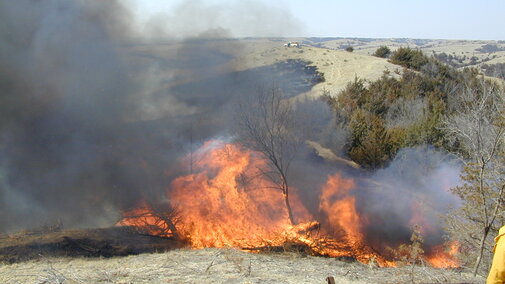Grazing Small Grains
By Todd Whitney

Now that small grains and cover crops are greening up, this is the time for finalizing your forage grazing plans. Small grains provide ample grazing opportunity. For every 1,000 pounds of forage dry matter production, there is potential beef gains of approximately 100 pounds.
Whether growing small grains or cover crops, grazing will be maximized if livestock producers wait until the plants are 4 to 8 inches tall before starting the grazing process. Then, stock the fields with enough animals to maintain plant heights between 6 and 12 inches. Flash grazing or dividing fields into smaller paddocks may prevent over grazing plants below the 6-inch target plant height.
For those wanting to graze wheat and rye and still harvest grain from the same fields — stop grazing the plants before they reach first hollow stem or jointing development. Grazing beyond the jointing stage may decrease grain yields 1% to 5% each day that grazing continues. This is because the grazing animals may be consuming grain heads in the immature tillers.
Timing of growth stage varies each year and depends on factors such as fall planting date, variety and spring soil conditions. First hollow stem occurs about a week prior to jointing when the immature head rises in the tiller above the soil surface. The jointing stage can be identified by feeling with your fingers a bump or joint on the tiller stems as you move your fingers up the stem from the soil surface. Generally, you will want to focus our growth stage assessment using the larger primary tillers.
With careful management such as delayed grazing, the cool-season grazing can be extended through mid-June.
Planning Prescribed Burning
By Jerry Volesky
Late March and April is a key time period when prescribed burning of pasture and CRP lands occurs. Within this time period, there are a limited number of days when weather conditions such as wind speed, direction and humidity meet the required prescription for the unit that is being burned. With this, having a detailed burn plan is needed to make sure the work is done safely.
The primary objective of most prescribed burns in Nebraska is to control eastern red cedar trees. However, prescribed burns can also improve grass stands, prepare them for interseeding, reduce annual grassy and broadleaf weeds, enhance wildlife habitat and improve forage quality.
Safe and controlled prescribed burns don’t just happen. It takes preparation, planning and an understanding of how fire reacts in certain weather conditions, with particular fuel loads and on various types of topography.
Prescribed fire is useful on CRP or other fields that are overgrown with dead growth from previous years. This mulch can smother plants and new seedlings, causing stands to thin. Fire removes this mulch, enabling stands to thicken and it improves wildlife habitat.
Timing of a prescribed fire is important. For warm-season grasses, a good time to burn is when they just start to grow, usually mid-April to early May. Burning then will result in rapid green-up and thickening of desirable warm-season plants and reduce invading cool-season grasses.
Plan your prescribed burn carefully and be aware of the topography and other factors that will affect how the fire behaves. Never burn unless weather conditions are within your burn prescription. Plus, make sure your burn is legal. You must obtain a burn permit from your local fire chief. And finally, it is always a great benefit to have someone experienced in prescribed burning as part of your burning crew.

